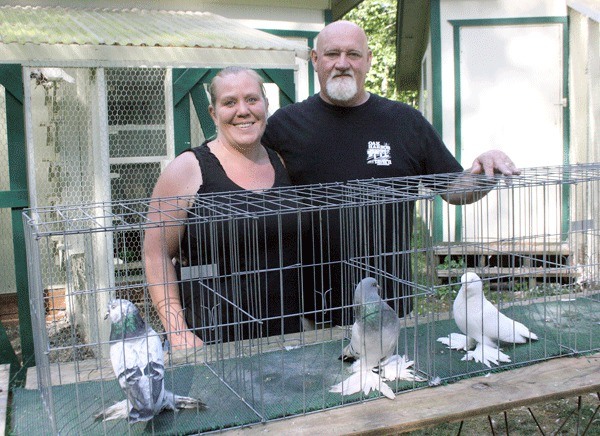If the gray pigeons strutting down city streets realized their wide variety of cousins, maybe they’d understand why people brush them aside. How can they compare to pigeons with feathers that curl up at the ends, or pigeons with white heads and black bodies, reminiscent of bald eagles?
As far as originality goes, ordinary pigeons can’t compare to pouters, pigeons with large globes on their chests that fill with air to attract mates, or naked-necked pigeons, their necks alone bare of feathers.
However, West of England Tumblers will outshine other pigeons any day with their unique addition to the art of flying: as they fly, they can roll tail first through the air, usually three to four times in a row, a survival skill to avoid predators.
“It’s something that’s naturally in the breed,” said Coupeville pigeon breeder Jim Cooper. He and his wife, Cynthia, breed, show and judge West of England Tumblers.
The Coopers have 120 pigeons. Their trilling coos and flapping wings fill the Coopers’ backyard, the warm smell of their lofts blending into the forest.
Tumblers have heavily-feathered feet and come in a variety of colors and patterns, from intricately-patterned Gray Lace tumblers to pure white or reddish to black pigeons with some iridescent purple and green feathers. Pigeon-showing isn’t widely-known but it’s a life-long thrill for the Coopers.
“It’s a hobby. We’re definitely not making money doing this; it’s for love of the hobby,” Jim said, adding that the fun of it is the camaraderie and sharing experiences with people who enjoy the same passion. Discussing breeding advice and bouncing ideas about which birds can produce certain colors when bred facinates him.
“It’s kind of a dying hobby; there are more adults than juniors. We want to get juniors involved in it and if they can, it really becomes a family thing. It gets the family together because families don’t do as much together now,” Cynthia said.
Both Jim and Cynthia grew up with families that cared about pigeons.
“It was a family affair growing up with them,” Cynthia said. Everyone in her family trained Racing Homer pigeons and sat waiting for them to return on race days.
Jim raised show birds and Racing Homers with his father and brother. Growing up in New York, there were shows to go to every weekend.
From the beginning, Jim’s and Cynthia’s relationship revolved around birds. They met at a show in San Bernadino, Calif.
The Coopers settled on the tumbler breed to show because they are docile.
“I like the looks of them and they come in so many different colors,” Jim said.
The Coopers attend approximately five shows per year. Most are out of state because there are few shows offered in Washington. Jim won national shows in 1998 and 2006 and Cynthia won nationally with another breed.
At shows, judges handle every bird to examine size, shape, bone structure, color placement on feathers, eye clarity, how the bird stands and other traits breeders work into the birds through specific breeding.
A “best of category” pigeon is selected for each color category: monotone birds called selfs; patterns, like tortoiseshell or Gray Lace, with precise color placement; mottled, which have certain percentages of colors all over; and baldheaded, which have white heads and colored bodies.
Those champions compete for champion of breed honors.
After Jim retired from the military and their children grew up, the Coopers had more time to travel to shows but the poor economy has caused travel prices to skyrocket. It used to cost $50 to transport pigeons roundtrip by airplane. Now, it costs $200 one way, Jim said.
They’ve chosen certain shows to attend this year in California, Louisiana, the national show in Florida and they will judge a show in Idaho.
In the meantime, the Coopers have breeding to think about.
Like showing dogs, breeders must match the birds to meet standards of color and body shape. That’s where genetics and terms like “masked genes” and “gene carriers” come into play.
“What I used to call ‘the old man’s sport’ has become scientific,” Jim said.
Jim notes every breeding and offspring on charts so that he knows what he’ll get from each pigeon. If two red birds breed and produce a yellow offspring, he discovered that one of the birds is carrying the gene for yellow but not expressing it. This way, he can create new color blends and perfect show-winning lines.
While the birds’ quality have attracted buyers worldwide, the Coopers only sell their birds occasionally, despite some offers exceeding $1,000 per bird.
“We spend a lot of time promoting and helping each other out,” Cynthia said about other pigeon breeders. “Instead of selling them for big bucks, we make trades or give them to youth so they can get started.”
Cynthia said they provide a pair of birds to interested young people so they can breed them. The repayment is the possibility that the youth will give the Coopers offspring in the future.
They’ve worked with 4-H clubs, Future Farmers of America and more to popularize their beloved hobby and they’re hopeful that children who grew up with pigeons may take on the hobby again in their 30s, as some of their friends have.
“It’s one of those passions you get in your blood and you can’t get rid of it,” Jim said.
“We do it just ‘cause we want to. I like doing shows and seeing people. I like to hope that one of these days when I’m gone, there’ll be a new generation to do it,” Jim said.
Those interested in tumbler breeding and showing can contact the Coopers at 678-7075 or visit the National Pigeon Association web site at www.npausa.com.



